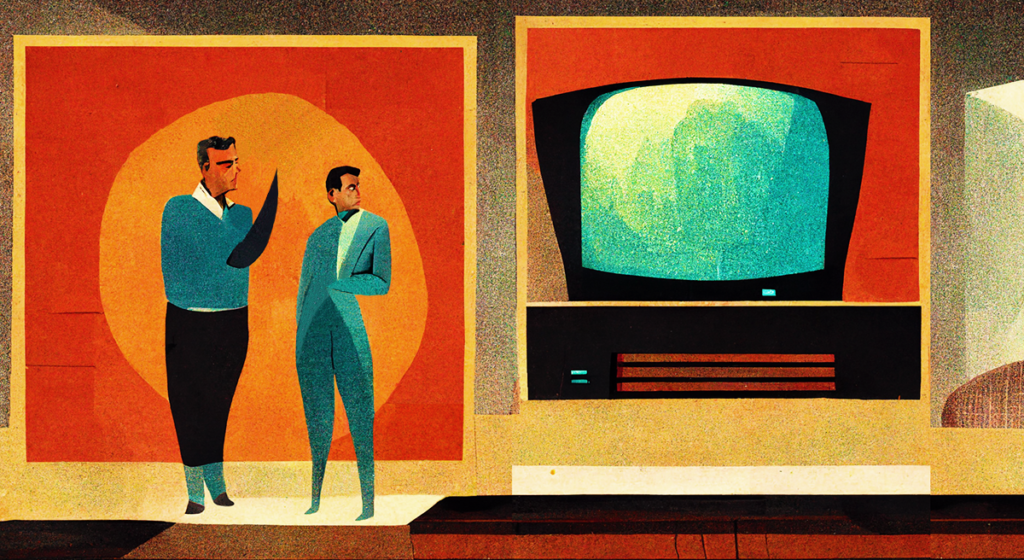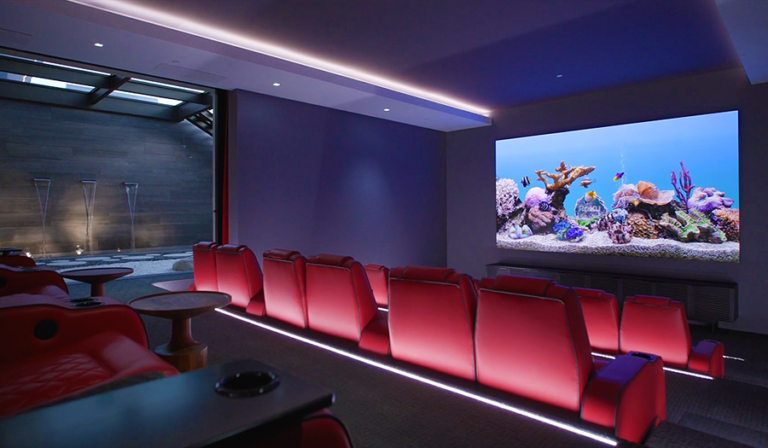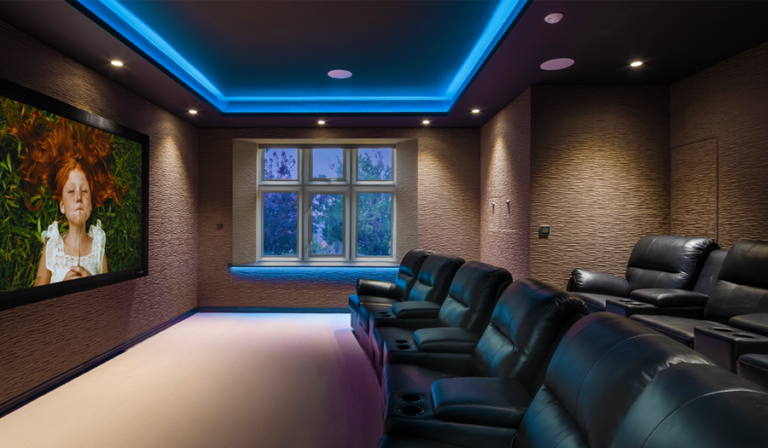“I don’t think I need to show any examples of the kinds of rooms I’m talking about. Everyone’s walked one of these crime scenes at some point in their life.”
The responsibility for creating entertainment spaces has traditionally fallen on the person least capable of doing the job—until now
by Michael Gaughn
September 29, 2022
For decades, the person with the most sway over the look of the entertainment spaces in most homes has been the one with the weakest sense of design—or no design sense at all. And I’m not just talking mass-market man caves but high-end home theaters, (the miserably named) media rooms, and other places where people like to enjoy their games, music, movies, and series.
And by design sense, I’m not talking the ability to make bold statements. An asset elsewhere in the home, those showier traits tend to be a negative in spaces where the room shouldn’t be allowed to overwhelm the experience. I’m just talking about what’s appropriate—what’s judicious and shows taste; what’s apt.
Interior designers are partly to blame for this hegemony. Traditionally tech averse, they far too easily ceded their ground here—which has been especially unfortunate because these spaces, with all their screens and devices and control, are essentially harbingers of what the entire home will soon be. Better to figure out now how to keep them from looking like domestic outliers than to have to tackle them later as a fait accompli.
So these design chores have too often fallen on the custom integrator instead. But expecting the average AV guy to bring some tact and flair to the proceedings is kind of like letting your lawn crew plan your daughter’s wedding. The parts of the
And by design sense, I’m not talking the ability to make bold statements. An asset elsewhere in the home, those showier traits tend to be a negative in spaces where the room shouldn’t be allowed to overwhelm the experience. I’m just talking about what’s appropriate—what’s judicious and shows taste; what’s apt.
Interior designers are partly to blame for this hegemony. Traditionally tech averse, they far too easily ceded their ground here—which has been especially unfortunate because these spaces, with all their screens and devices and control, are essentially harbingers of what the entire home will soon be. Better to figure out now how to keep them from looking like domestic outliers than to have to tackle them later as a fait accompli.
So these design chores have too often fallen on the custom integrator instead. But expecting the average AV guy to bring some tact and flair to the proceedings is kind of like letting your lawn crew plan your daughter’s wedding. The parts of the brain needed to run wire, decipher specs, patch together a system, and calibrate a room don’t tend to be on speaking terms with the areas needed to fully grasp a client’s lifestyle or empathize with their more subtle aesthetic needs—essential traits for being able to create a suitable, inviting space that doesn’t feel utterly alien from the rest of the home.
brain needed to run wire, decipher specs, patch together a system, and calibrate a room don’t tend to be on speaking terms with the areas needed to fully grasp a client’s lifestyle or empathize with their more subtle aesthetic needs—essential traits for being able to create a suitable, inviting space that doesn’t feel utterly alien from the rest of the home.
The most positive way to spin all this is to say integrators jumped into the breach because no one else wanted to take on the job, and there’s more than a little truth to that. Less charitably, it could be said that their zeal to pile as much
gear as possible into a room with little concern for its impact on the experience or the space caused architects and designers who could have helped smooth the waters to throw up their hands and walk away.
I don’t think I need to show any examples of the kinds of rooms I’m talking about. Everyone’s walked one of these crime scenes at some point in their life. The number of atrocities committed in the name of home theater is so massive it warrants a war crimes tribunal.
But this once dire situation is changing for the better—and fast—as a new generation of architects and designers emerges that, having been weaned on
The most positive way to spin all this is to say integrators jumped into the breach because no one else wanted to take on the job, and there’s more than a little truth to that. Less charitably, it could be said that their zeal to pile as much gear as possible into a room with little concern for its impact on the experience or the space caused architects and designers who could have helped smooth the waters to throw up their hands and walk away.
I don’t think I need to show any examples of the kinds of rooms I’m talking about. Everyone’s walked one of these crime scenes at some point in their life. The number of atrocities committed in the name of home theater is so massive it warrants a war crimes tribunal.
But this once dire situation is changing for the better—and fast—as a new generation of architects and designers emerges that, having been weaned on lifestyle tech, no longer views it as the enemy—but also doesn’t stroke it as a fetish—and knows how to make it feel like a not just unintrusive but organic part of the home.
lifestyle tech, no longer views it as the enemy—but also doesn’t stroke it as a fetish—and knows how to make it feel like a not just unintrusive but organic part of the home.
Flexible, innovative private cinemas like the one featured in “Achieving Serenity” show just how fluid this has all become. Architect Ty Harrison also functioned as the lead designer—which, in a home that ambitious, meant also having to have a good grasp of how to integrate sophisticated and elaborate enough entertainment systems to satisfy the client’s needs. He then brought in the right integrator to make all the behind-the-scenes
technical stuff happen, who in turn assembled the right team of specialists to handle things like the acoustics and calibration.
That is how it should be—an architect or interior designer attuned to the client’s lifestyle who can then translate their desires structurally, technically, and aesthetically.
I’m not saying there are no integrators capable of rising to the challenge, just that the hopeless gear-heads among them should never be allowed within striking
distance of a book of swatches. The exceptions tend to be members of the emerging generation, with some functioning basically as design firms that are also able to handle the tech—like the British outfit Equippd, profiled in “Secret Cinema.” As up on look and feel as they are on gear, they always place the latter clearly in the service of the former. And because they get design and know how to make it exciting without letting it overwhelm an entertainment space, it’s something they can offer enthusiastically, not grudgingly or ineptly.
Thanks to the ascendance of these tech-savvy architects
Flexible, innovative private cinemas like the one featured in “Achieving Serenity” show just how fluid this has all become. Architect Ty Harrison also functioned as the lead designer—which, in a home that ambitious, meant also having to have a good grasp of how to integrate sophisticated and elaborate enough entertainment systems to satisfy the client’s needs. He then brought in the right integrator to make all the behind-the-scenes technical stuff happen, who in turn assembled the right team of specialists to handle things like the acoustics and calibration.
That is how it should be—an architect or interior designer attuned to the client’s lifestyle who can then translate their desires structurally, technically, and aesthetically.
I’m not saying there are no integrators capable of rising to the challenge, just that the hopeless gear-heads among them should never be allowed within striking distance of a book of swatches. The exceptions tend to be members of the emerging generation, with some functioning basically as design firms that are also able to handle the tech—like the British outfit Equippd, profiled in “Secret Cinema.” As up on look and feel as they are on gear, they always place the latter clearly in the service of the former. And because they get design and know how to make it exciting without letting it overwhelm an entertainment space, it’s something they can offer enthusiastically, not grudgingly or ineptly.
Sign up for our monthly newsletter to stay up to date on Cineluxe
Thanks to the ascendance of these tech-savvy architects and designers, and a small but growing coterie of integrators, entertainment spaces are, after far too long, becoming congruent with people’s expectations and how they actually live their lives. We’re far from free of the butt-crack brigade and their zeal for pushing tweaked-out unloved and unlovely rumpus rooms, but the glow of their pocket flashes is waning fast. There will always be a need to have someone run wire—the same way you’ll always need a plumber. But design will never be the AV guy’s strong suit and the coming paradigm shift will not only open up fertile new territory but help finally restore the natural order of things.
and designers, and a small but growing coterie of integrators, entertainment spaces are, after far too long, becoming congruent with people’s expectations and how they actually live their lives. We’re far from free of the butt-crack brigade and their zeal for pushing tweaked-out unloved and unlovely rumpus rooms, but the glow of their pocket flashes is waning fast. There will always be a need to have someone run wire—the same way you’ll always need a plumber. But design will never be the AV guy’s strong suit and the coming paradigm shift will not only open up fertile new territory but help finally restore the natural order of things.
Michael Gaughn—The Absolute Sound, The Perfect Vision, Wideband, Stereo Review, Sound & Vision, The Rayva Roundtable, marketing, product design, some theater designs, a couple TV shows, some commercials, and now this.
© 2023 Cineluxe LLC





